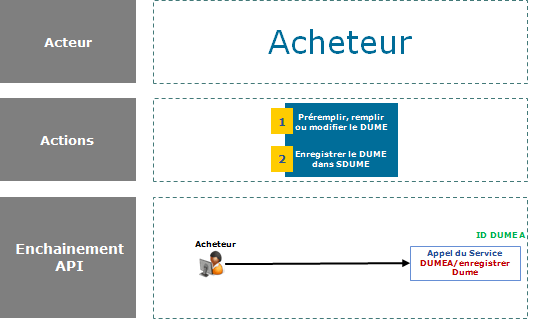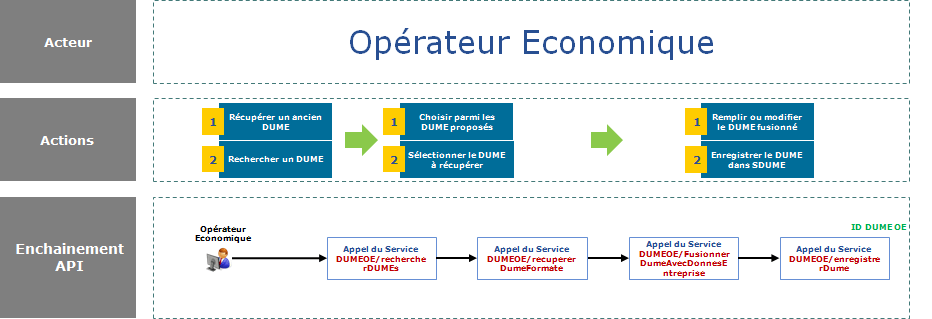Presentation of kinematics’ use
The kinematics presented below allow you to understand the context in which to implement the APIs of the ESPD Service.
Although APIs are provided by AIFE, the publisher must think about the Human Machine Interface between each call.
Les différents enchainements proposés ici illustrent une utilisation minimale du DUME. Il est recommandé à chaque éditeur d’adapter les cinématiques à son profil d’acheteur afin de prévoir une utilisation plus avancée et plus simplifiée des fonctionnalités du Service DUME.
The API "recupererModelDume" enables to retrieve a blank ESPD template.
In the following kinematics, it is accepted that the buyer profile retrieves the ESPD template beforehand.
The user itinerary described here implies that the user wishes to benefit from the functionalities offered by the ESPD when creating the call for tenders.
1. Cases where the buyer wishes to leave from an old ESPD
When a DUME is saved in draft status, it is stored in the DUME Service repository and can be modified by the buyer at any time. The ESPD Service also assigns an identifier number to this ESPD.

When a ESPD is registered in the validated status, it is stored in the ESPD Service repository and is given an identifier number. At this stage, the ESPD cannot be modified by the buyer. In the event that the buyer has forgotten a selection criterion or other structuring element, he will still be able to replace his ESPD. This means that the buyer will create a new ESPD which will be assigned a new identifier number and which will replace the old, then expired ESPD.
2. When the buyer wishes to create a new ESPD

When an ESPD is saved in draft status, it is stored in the ESPD Service repository and can be modified by the buyer at any time. The ESPD Service also assigns an identifier number to this ESPD. When a ESPD is registered in the validated status, it is stored in the ESPD Service repository and is given an identifier number. At this stage, the ESPD cannot be modified by the buyer. It can only be replaced and will be assigned a new ID number.
Lorsqu’un DUME est enregistré au statut validé, il est stocké dans le référentiel Service DUME et se voit confié un numéro d’identifiant. A ce stade, le DUME ne peut être modifié par l’acheteur. Il pourra uniquement être remplacé et se verra attribué un nouveau numéro d’identifiant.
The user itinerary described here implies that the economic operator has chosen to benefit from the functionalities offered by the ESPD to respond to a call for tenders.
For the use of an Economic Operator ESPD, we will identify two main cases of ESPD use. In one case, the economic operator will respond to an ESPD that was previously created by the buyer whereas in the other case, the economic operator will go back from an Economic Operator ESPD to formulate his or her response.
On a functional level, responding to a buyer ESPD enables the economic operator to only go back from the selection criteria set by the buyer.
1.Answer to a buyer ESPD with a former economic operator ESPD

2. Answer to a buyer ESPD with a new economic operator ESPD

3.Answer without buyer ESPD with a former economic operator ESPD

4. Answer without buyer ESPD with a new economic operator ESPD

1. The case of allotted markets
- buyers to create a call for tenders containing several lots.
- economic operators to respond to one or several lots from one call for tenders.
A buyer can create a lot contract via one or several ESPDs and can formulate selection criteria that differ from one lot to another.
The economic operator can, in the context of apportioned contracts:
- present a Economic Operator ESPD in global containing all of the selection criteria present in the Buyer ESPD lots.
- present an ESPD by lot if the selection criteria differ from one lot to another.
At a minimum, the economic operator must present as many Economic Operator ESPDs as there are Buyer ESPDs created by the buyer.
2.The case of markets with co-contractors and subcontractors
In this case, it is up to the representative to respond to the call for tenders with an ESPD indicating the connections with the other stakeholders' ESPDs.

Last Update: January 29, 2020



